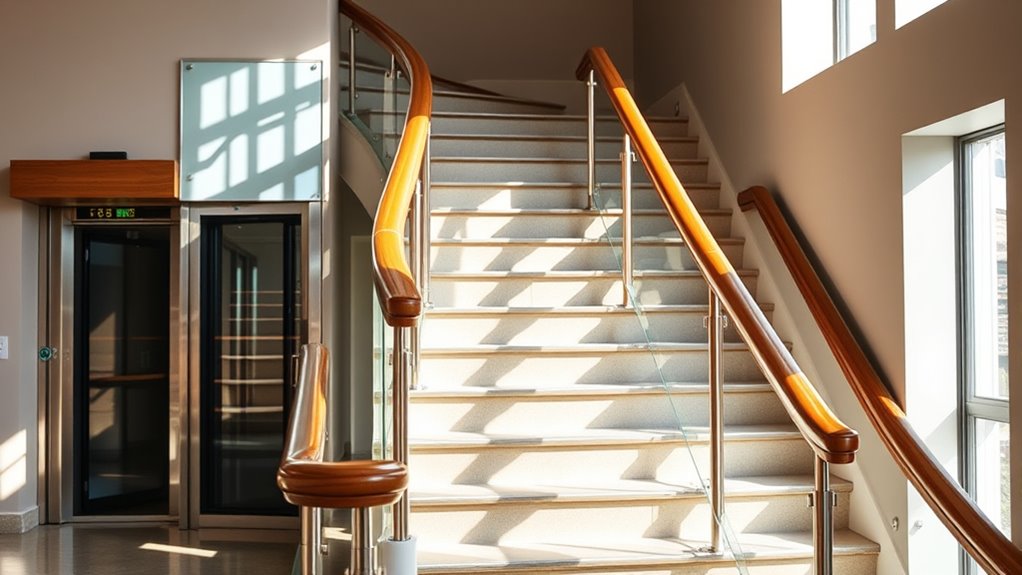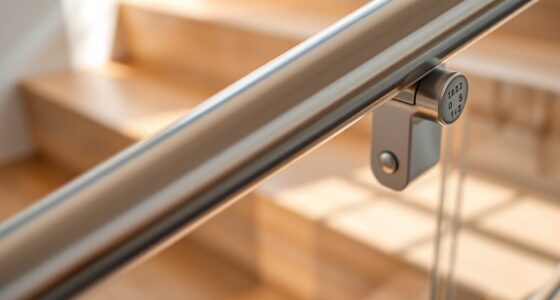To improve stair safety, choose sturdy handrails that meet safety standards, are comfortable to grip, and fit your space. Prepare your staircase by measuring height and width, marking bracket positions, and securing brackets into wall studs or anchors. For added accessibility, consider installing a stair lift suited to your staircase type. Regular inspections and maintenance guarantee both handrails and lifts stay secure and functional. Keep exploring for detailed tips to make your stairs safer and more accessible.
Key Takeaways
- Select handrails that meet safety standards, ensuring proper height, support, and material for comfort and grip.
- Measure and mark precise locations for brackets, securing them into wall studs or anchors for stability.
- Install handrails on both sides at 34-38 inches above stair nosing to enhance support and safety.
- Choose stair lifts based on staircase configuration, width, and power source, ensuring proper installation and compliance.
- Regularly inspect and maintain handrails and lifts to ensure ongoing safety and functionality.
Selecting the Right Handrails and Support Features
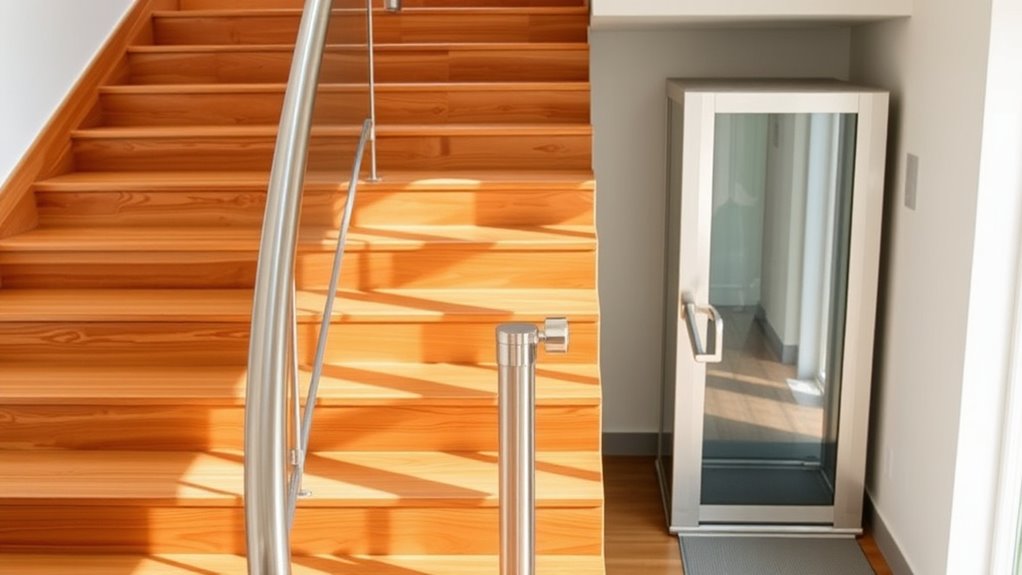
Choosing the right handrails and support features is vital for stair safety. You need to select handrails that meet safety standards, typically installed at 34-38 inches from the stair nosing for ideal support. Proper support features, like sturdy handrails on both sides, reduce fall risks and promote better posture during ascent and descent. The material and grip design—such as textured metal or wood—play an indispensable role in safety and comfort. When choosing support features, consider your staircase’s width, space limitations, and user mobility needs to guarantee a proper fit. Meeting safety standards ensures your support features provide dependable assistance. Additionally, selecting appropriate support features can significantly enhance user confidence and prevent accidents. Studies indicate that well-designed handrails and support features can also increase the overall safety and accessibility of stairways for all users. Incorporating ergonomic grip designs can further improve user comfort and reduce fatigue during use. Moreover, understanding building codes and safety guidelines helps ensure compliance and optimal safety performance.
Preparing Your Space for Handrail Installation
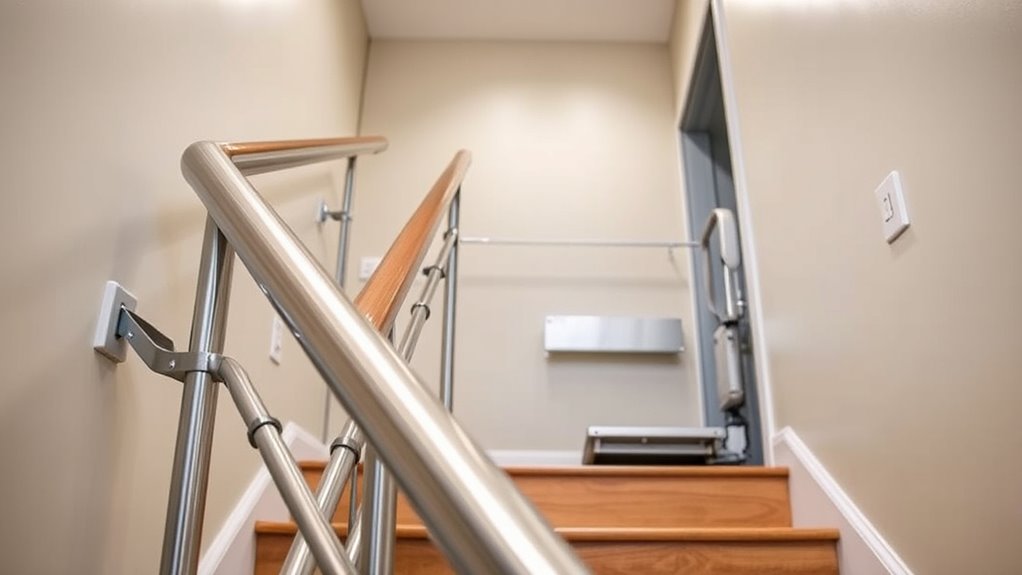
Before installing your handrail, it’s important to prepare the space properly. First, measure the staircase height and width to determine the correct handrail length and placement, ensuring safety standards are met. Use a stud finder or wall anchors to identify secure mounting points, avoiding electrical wiring or plumbing. Mark bracket positions at 34-38 inches from the stair nosing with a level for straight alignment. Clear debris and obstacles from the area to create a safe workspace. Verify the wall surface can support the brackets and handrail, choosing appropriate screws or anchors based on drywall, plaster, or brick. Proper installation techniques will ensure longevity and safety of your handrails. Additionally, understanding building codes and safety guidelines can help ensure your installation complies with local regulations and provides maximum safety. Ensuring your handrail height standards are met is crucial for both safety and compliance. Being aware of credit card security measures can also be beneficial if your project involves online resources or digital payments related to your home improvement needs.
Step-by-Step Guide to Installing Handrails Safely
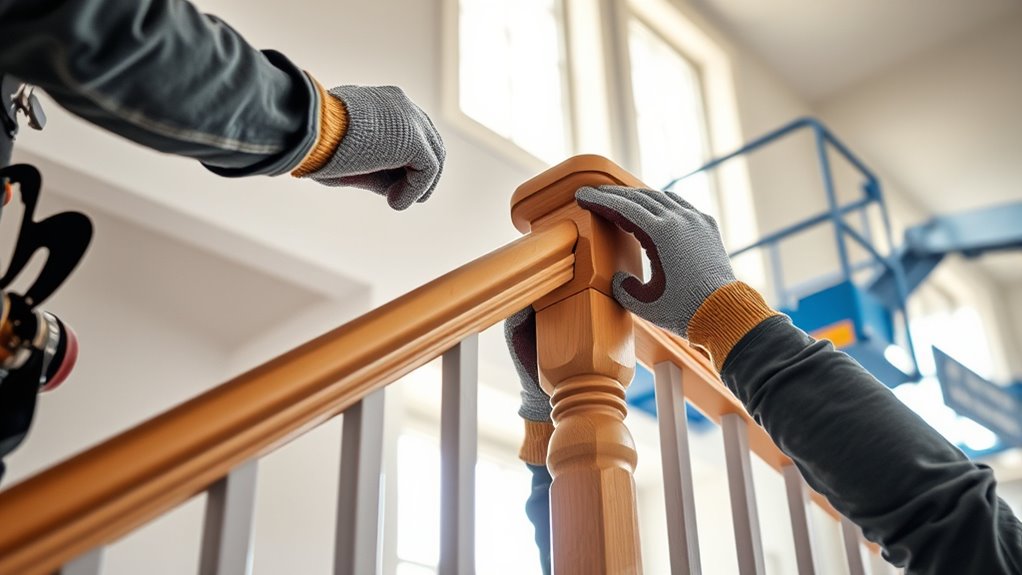
Start by accurately measuring and marking the height for your handrail, ensuring it’s between 34-38 inches from the stair nosing. Then, locate wall studs or use anchors to secure brackets, making sure they’re level and aligned with the stairs. To enhance safety and durability, consider selecting brackets and handrails made from sustainable materials that complement your farmhouse aesthetic. Additionally, choosing durable and weather-resistant materials can help ensure the handrail remains secure over time, especially in high-traffic or outdoor areas. When selecting materials, it’s important to consider their color accuracy to match your home’s decor seamlessly. Incorporating self-watering plant pots into your outdoor design can also add a touch of greenery that’s easy to maintain in various weather conditions. Furthermore, utilizing advanced fastening techniques can improve the overall sturdiness of your installation. Finally, attach the handrail to the brackets, check for stability, and perform a final tug to confirm it’s firmly mounted.
Marking and Measuring Properly
To guarantee your handrails are installed safely and comfortably, accurate marking and measuring are essential. Start by measuring from the stair nosing to the desired handrail height, usually 34-38 inches. Use a level to draw straight, horizontal lines along the wall as guides for bracket placement. Mark exact points for brackets, aligning them with stair treads and spacing them every 36 inches or per local codes. To ensure secure attachment, locate wall studs with a stud finder before marking bracket positions, especially on drywall. Double-check all measurements with a measuring tape and a level before drilling. Proper marking ensures stability and safety for your handrails, brackets, and overall stair support. Additionally, understanding building safety standards can help you ensure compliance during your project planning and mitigate potential pitfalls in adopting new payment technologies. Paying attention to proper measurement techniques is also crucial in achieving a safe and durable installation. Using a precision measuring tool can further enhance accuracy and ensure your installation meets safety requirements.
Securing and Testing Stability
Ensuring your handrails are secure and stable is essential for safety, and proper installation steps make all the difference. Start by marking the brackets’ exact placement on the wall, ensuring they align with the staircase’s incline and are level using a spirit level. Use vertical storage solutions to help determine the correct height for the handrails, ensuring they are accessible and comfortable to grip. Secure the brackets into wall studs or appropriate anchors with screws designed for your wall type, applying firm pressure to prevent wobbling. Place the handrail onto the mounted brackets, then verify that it’s level and properly aligned before tightening all screws securely. Properly anchoring handrails helps promote sustainable building practices and long-term safety. Incorporating automation technologies in installation can streamline the process and improve accuracy. Utilizing power tools can also make the installation faster and ensure screws are driven in securely. Conducting a comprehensive safety check after installation ensures all components are firmly in place and functioning as intended. After installation, tug gently on the handrail to test its stability, making any necessary adjustments to eliminate wobbling or shifting. Confirm all screws are tight, the handrail is firm, and the entire assembly meets safety standards before use.
Choosing and Installing Appropriate Stair Lifts
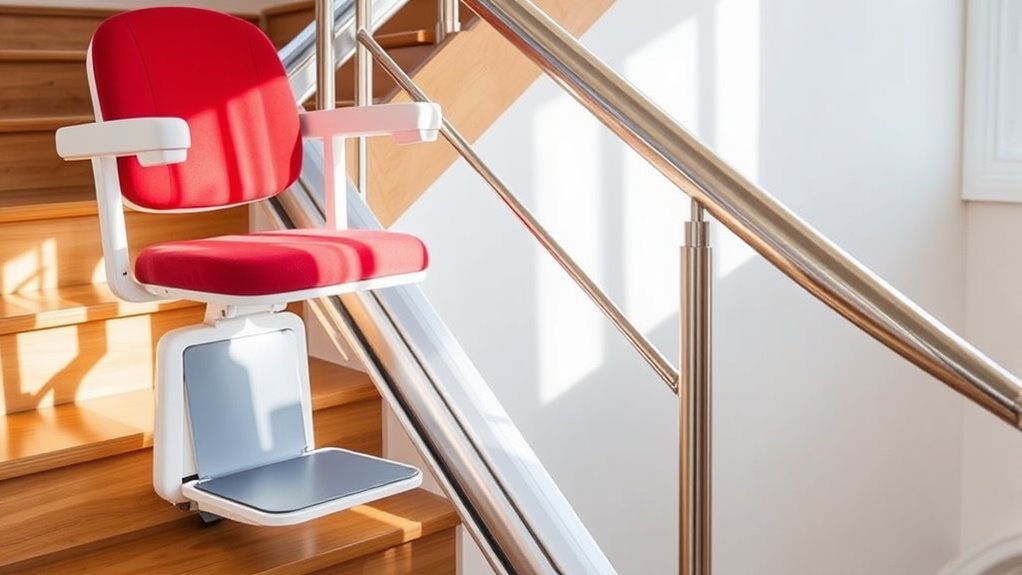
Choosing the right stair lift begins with evaluating your staircase’s configuration and dimensions. Determine if your staircase is straight or curved, as this affects whether you need a straight or curved stair lift. Straight lifts are generally less expensive, costing between $3,000 and $5,000, while curved models can range from $10,000 to $15,000. Make sure your staircase width is at least 36 inches to comfortably accommodate the lift, though narrower options exist for spaces as tight as 28 inches. Confirm there’s a nearby power outlet within 5 feet or plan electrical upgrades for the lift’s motor. Have a professional assess your staircase’s slopes, rail length, and headroom clearance to ensure a proper fit and safe operation during installation. Additionally, ensuring proper staircase safety features can contribute to a secure environment for lift use and overall home safety. Incorporating effective communication with your installer can help clarify requirements and address any concerns during the process. Being aware of home safety standards can further ensure that your installation complies with safety regulations and best practices.
Maintaining and Inspecting Safety Devices Over Time
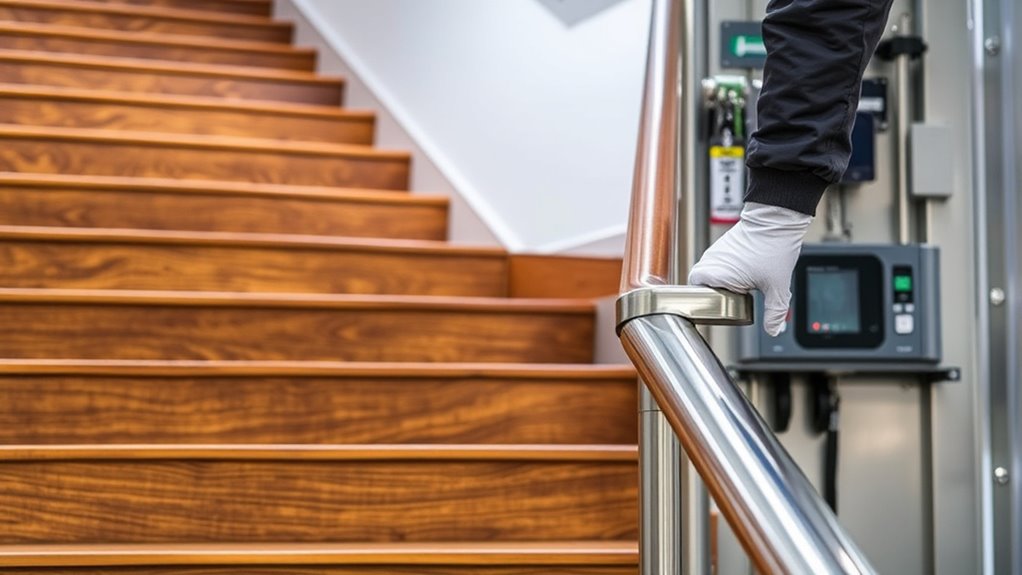
Regularly inspecting your safety devices is essential to keep your stairway secure. You should check handrails and stair lifts for loose screws, wobbling, or damage, tightening or repairing as needed to ensure stability. Test stair lift batteries periodically and replace them based on manufacturer guidelines for reliable operation. Clean safety devices with appropriate materials to prevent dirt buildup that could reduce grip or hinder mechanical parts. Schedule professional maintenance at least once a year to spot wear, corrosion, or other safety hazards early. Keep a detailed record of inspections and repairs to monitor the lifespan of your safety devices and plan timely upgrades. Use the table below to help organize your safety inspection routine:
| Task | Frequency | Notes |
|---|---|---|
| Inspect handrails/lifts | Monthly | Tighten/repair as needed |
| Test batteries | Quarterly | Replace per guidelines |
| Schedule professional check | Annually | Address wear or corrosion |
Tips for Creating an Accessible and Secure Stair Environment
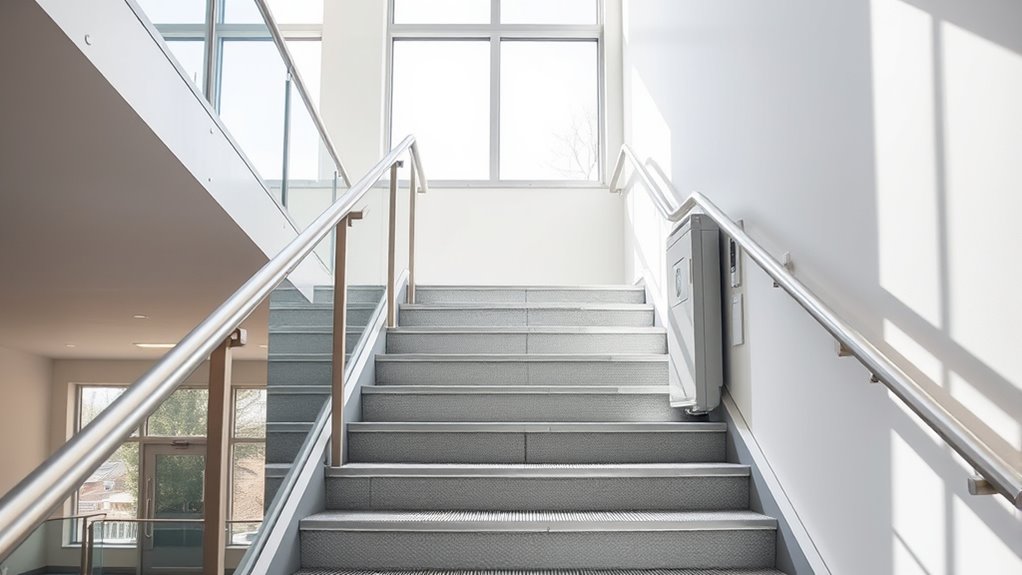
Creating a safe and accessible stair environment begins with proper design and installation. Start by installing handrails on both sides of the staircase at 34-38 inches above the stair nosing to provide solid support. Use sturdy brackets secured into wall studs or anchors that support at least 200 pounds for safety.
Incorporate stair lifts or dual rail systems to improve accessibility, especially for those with limited mobility or balance challenges. Ensure pathways are at least 36 inches wide and free of obstructions, allowing for easy movement and use of mobility aids.
Regularly inspect and maintain handrails and lifts to confirm stability and proper functioning. By following these tips, you create a stair environment that’s both secure and accessible for everyone.
Frequently Asked Questions
What Are the Safety Requirements for Stair Railings?
When considering stair safety requirements for railings, you need to guarantee they’re installed on at least one side if your stairs have four or more steps.
The handrails should be 34-38 inches high, continuous, and securely anchored.
Make sure they’re graspable with a diameter of 1 1/4 to 2 inches, with a smooth surface.
Also, leave at least 1 1/2 inches between the handrail and the wall for safe gripping.
What Are the ADA Guidelines for Stair Handrails?
You’re asking about ADA guidelines for stair handrails. These guidelines require your handrails to be continuous along the full length of stairs on both sides when possible.
They should be mounted between 34 and 38 inches above stair nosing, with a diameter of 1 1/4 to 2 inches for a secure grip.
Make certain the handrails have non-slip surfaces, are securely mounted, and maintain at least 1 1/2 inches of space from the wall for easy grasping.
How Far Should a Handrail Extend Past the Bottom Step?
This question might seem simple, but it’s vital for your safety. You should extend your handrail at least 12 inches beyond the bottom step. This extra length gives you a firm grip before stepping on or off the stairs, reducing the risk of falls.
Some guidelines even suggest extending it further, matching the top handrail, to guarantee maximum support and safety during descent.
Do Handrails Need to Be Mounted on Studs?
When you’re mounting a handrail, it’s best to secure it on studs because they provide the strongest support. You should locate studs using a stud finder and attach the handrail to at least two of them for maximum stability.
If studs aren’t available, use appropriate wall anchors or blocking to make certain the handrail stays securely in place. Keeping your staircase safe and sturdy is the ultimate goal.
Conclusion
By installing the right handrails and stair lifts, you dramatically reduce fall risks—studies show that proper handrails can cut stair-related injuries by up to 85%. Regular maintenance and inspections guarantee these safety features stay effective. Remember, making your stairs accessible and secure isn’t just about compliance; it’s about protecting yourself and loved ones every day. Take action now to create a safer, more confident stair environment for everyone.
